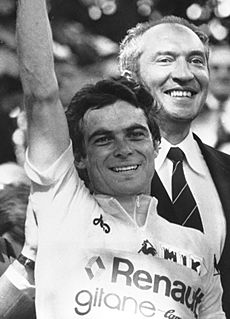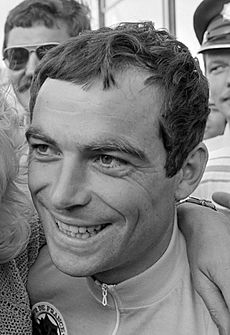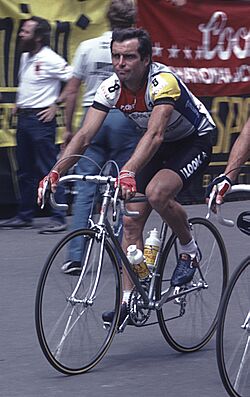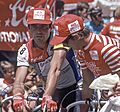Bernard Hinault facts for kids

Hinault at the 2012 Critérium du Dauphiné
|
|||
| Personal information | |||
|---|---|---|---|
| Full name | Bernard Hinault | ||
| Nickname |
|
||
| Born | 14 November 1954 Yffiniac, France |
||
| Height | 1.74 m (5 ft 8+1⁄2 in) | ||
| Weight | 62 kg (137 lb; 9 st 11 lb) | ||
| Team information | |||
| Current team | Retired | ||
| Discipline | Road | ||
| Role | Rider | ||
| Rider type | All-rounder | ||
| Major wins | |||
|
|||
Bernard Hinault (born 14 November 1954) is a famous French former professional road cyclist. He won 147 races during his career, including the Tour de France five times. Many people consider him one of the greatest cyclists ever. Hinault competed in 13 major cycling events called Grand Tours. He won 10 of them, which is an amazing achievement! Only Eddy Merckx has won more. No cyclist since Hinault has won more than seven Grand Tours.
Hinault started cycling as a young amateur in his home region of Brittany, France. After doing very well as an amateur, he became a professional in 1975 with the Gitane–Campagnolo team. He had big wins in 1977 at the Liège–Bastogne–Liège race and the Critérium du Dauphiné Libéré stage race. In 1978, he won his first two Grand Tours: the Vuelta a España and the Tour de France.
In the years that followed, Hinault was the top cyclist. He won another Tour de France in 1979 and the Giro d'Italia in 1980. Even though a knee injury made him leave the 1980 Tour de France while he was in the lead, he came back to win the World Championship road race later that year. He won another Tour de France in 1981. Then, in 1982, he achieved a special feat: winning both the Giro d'Italia and the Tour de France in the same year.
After winning the Vuelta a España in 1983, his knee problems returned. This meant he missed the Tour de France that year, which his teammate Laurent Fignon won. Hinault then left his team and joined La Vie Claire. With his new team, he raced the 1984 Tour de France but finished second to Fignon. He bounced back in 1985, winning both the Giro d'Italia and the Tour de France again, with help from his teammate Greg LeMond. In the 1986 Tour de France, Hinault and LeMond had a friendly rivalry, and LeMond won his first Tour. Hinault retired at the end of that season. He is still the most recent French cyclist to win the Tour de France. After his cycling career, Hinault became a farmer and also worked for the Tour de France organizers until 2016.
Throughout his career, Hinault was known as Le Blaireau, which means "The Badger." He liked this nickname because badgers are known for being tough and determined, just like he was when he raced. Other cyclists also saw him as Le Patron, or "The Boss," because he was a strong leader in the races.
Contents
Early Life and His Start in Cycling
Bernard Hinault was born on 14 November 1954 in a small village called Yffiniac in Brittany, France. He was the second of four children. His parents were farmers, and Bernard often helped them with farm work. He was a very energetic child, and his mother even called him a "little hooligan." Bernard wasn't the best student, but he went to a technical college to learn engineering. There, he started doing athletics, like running, and even finished tenth in a national cross-country race for young athletes in 1971.
In December 1974, just before he became a professional cyclist, Hinault married Martine. They had two sons, Mickael and Alexandre. While he was a professional cyclist, his family lived near his hometown. After he retired, they moved to a farm in Brittany.
Bernard Hinault is not related to another cyclist named Sébastien Hinault, even though they share the same last name and birthplace.
Amateur Cycling Career
Hinault got into cycling because of his cousin, René, who raced on weekends. At first, Bernard had to share the family bike, but he loved riding it. When he was 15, he got his own bike as a reward for passing his school exams. He used it to ride to college. In the summer of 1971, he trained with René, who was an experienced amateur rider. Even so, 16-year-old Bernard often found it easy to keep up with him.
Hinault got his racing license in April 1971 and entered his first race on 2 May. He was told just to try and stay with the other riders, but he ended up winning the race! Hinault won his first five races and had 12 wins out of 20 races by the end of that year. His father wasn't sure about Bernard pursuing cycling as a career, but he changed his mind after Bernard ran away for three days to stay with his cousins.
In 1972, Hinault was allowed to race against older riders (over 18). He won 19 races that year, including the national junior championship. He then joined the military for a year in 1973 and didn't race. When he returned in 1974, he was a bit out of shape but still won his first race. This was his last amateur season, and he had many more wins. He also competed in track cycling and won a national championship. Towards the end of 1974, Hinault decided to become a professional cyclist in 1975.
Professional Cycling Journey
Starting as a Pro (1975–1977)
In January 1975, Bernard Hinault became a professional cyclist with the Gitane–Campagnolo team. He earned a small salary at first. Early on, he showed he wasn't afraid to challenge older, more experienced riders. In one race, he won all the small cash prizes, even when five-time Tour de France winner Eddy Merckx tried to include him in a deal to share money. Hinault had a great first year, finishing seventh in the Paris–Nice race and winning the Circuit de la Sarthe.
In 1976, Cyrille Guimard, a former professional cyclist, became the team manager. Guimard and Hinault worked well together. Hinault focused on improving in smaller races, winning the Paris–Camembert and the Circuit de la Sarthe again. He won 15 races in 1976 and finished sixth at the World Championship Road Race.
In 1977, Hinault won two big races: Gent–Wevelgem and Liège–Bastogne–Liège, which was his first win in one of cycling's "monuments" (the most important one-day races). He also won the Critérium du Dauphiné Libéré, a key preparation race for the Tour de France. During this race, he crashed down a mountainside but bravely got back on a new bike and won the stage. This showed everyone how tough he was.
Renault Team Success (1978–1983)
First Grand Tour Wins (1978)
In 1978, Hinault competed in his first Grand Tour, the Vuelta a España in Spain. He won five stages and took the overall victory. Later that year, he raced in his first Tour de France. He had a strong rival in Joop Zoetemelk. During the Tour, the riders protested about having too many stages in one day. Hinault was chosen to speak for the riders, showing his leadership. He eventually won his first Tour de France by nearly four minutes. After the Tour, he won the Grand Prix des Nations, a time trial race.
Another Tour de France Victory (1979)
The 1979 Tour de France was another close battle between Hinault and Zoetemelk. Hinault won several stages, including mountain time trials. He faced challenges, like getting two flat tires on a cobbled section, which made him lose time. But he fought back, winning more stages and eventually securing his second Tour de France victory. He also won the Giro di Lombardia, another important one-day race, and was named the best rider of the season.
Chasing the Triple Crown (1980)
In 1980, Hinault aimed to win the "Triple Crown of Cycling," which means winning the Giro d'Italia, the Tour de France, and the World Championship in the same year. He started by winning the Liège–Bastogne–Liège race in very cold, snowy conditions. He won by almost ten minutes, but his fingers suffered from frostbite for weeks.
He then won the Giro d'Italia, taking the lead on a tough mountain stage. However, his dream of the Triple Crown ended when a knee injury forced him to leave the 1980 Tour de France while he was in the lead. Despite this, he came back to win the World Championship road race later that year on a very difficult course in France.
Third Tour de France Win (1981)
Hinault was not a fan of racing on cobbled roads, but he returned to Paris–Roubaix in 1981 as the World Champion. Despite crashing seven times and having flat tires, he won the race! He also won the Amstel Gold Race and dominated the Dauphiné Libéré.
In the Tour de France, Hinault took an early lead and never gave up the yellow jersey. He won five stages, including all four individual time trials. He secured his third Tour de France victory by a large margin.
Winning the Giro-Tour Double (1982)
Hinault returned to the Giro d'Italia in 1982 and won it, taking a significant lead in the second week. He then went on to win the Tour de France as well, completing the "Giro-Tour double" (winning both in the same year). He won four stages in the Tour, including the final stage on the famous Champs-Élysées in Paris.
Second Vuelta Victory (1983)
In 1983, Hinault raced the Vuelta a España with two young teammates, Laurent Fignon and Greg LeMond. He faced tough competition from Spanish riders. Hinault's knee pain returned during the race, but he fought hard, winning two stages and his second Vuelta victory. The race was very exciting and is remembered as one of the best. After the Vuelta, his knee problems forced him to miss the Tour de France, which his teammate Fignon won.
La Vie Claire Team (1984–1986)
Rivalry with Fignon (1984)
By 1983, Hinault's relationship with his team manager had become difficult. He decided to leave and join a new team called La Vie Claire. This team was known for its new training methods. In the Paris–Nice race, Hinault was involved in an incident with protesters who blocked the road. He tried to get through, and in the confusion, he got a broken rib.
The 1984 Tour de France was a big showdown between Hinault and his former teammate Fignon. Hinault won the prologue, but Fignon's team was strong. Hinault struggled in the time trials, which he usually dominated. On a tough mountain stage, Fignon dropped Hinault, and Hinault finished second overall, ten minutes behind Fignon. Despite the Tour defeat, Hinault bounced back in the fall, winning the Grand Prix des Nations and the Giro di Lombardia for a second time.
Another Giro-Tour Double (1985)
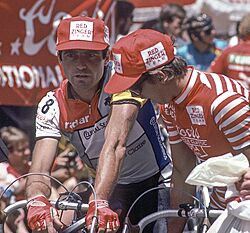
In 1985, Greg LeMond joined Hinault at La Vie Claire. They raced the Giro d'Italia together. Hinault won his third Giro, despite some hostility from the home crowd who supported a local rider.
In the 1985 Tour de France, Fignon was injured, so Hinault was the favorite. He won the opening stage in his home region of Brittany. His team, La Vie Claire, was very strong. Hinault took the race lead and built a big advantage over LeMond, who was now in second place. On one stage, Hinault crashed and finished with a broken nose. He also started to feel unwell. On a mountain stage, LeMond was told by the team not to attack Hinault, even though Hinault was struggling. This decision helped Hinault secure his record-equalling fifth Tour de France victory. After the race, Hinault publicly promised to help LeMond win the Tour the next year.
The Final Season (1986)
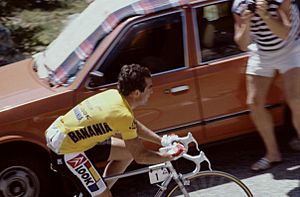
Bernard Hinault had announced he would retire on his 32nd birthday in November 1986. Even though he had promised to support LeMond in the 1986 Tour de France, many people wondered if Hinault would try to win a record sixth Tour himself.
Hinault took the lead in the general classification during the race. On a mountain stage, he attacked and gained a lot of time on LeMond. However, on another tough mountain stage, Hinault struggled and lost the yellow jersey to LeMond. On the famous Alpe d'Huez climb, Hinault and LeMond crossed the finish line together, holding hands, which seemed like a sign of friendship. But Hinault later said the race wasn't over. In the final time trial, Hinault won the stage but couldn't gain enough time to beat LeMond. He finished second overall, three minutes behind LeMond. Hinault won the mountains classification and was given a special award for being the most combative rider. His constant attacks and refusal to give up made LeMond feel a bit betrayed, even though LeMond won.
After the Tour, Hinault won the Coors Classic race in the United States. He rode his last competitive race, a criterium in France, on 19 September. Bernard Hinault officially retired from professional cycling on 14 November 1986. His retirement was celebrated with a big event in his hometown, with thousands of riders, a concert, and fireworks.
Life After Cycling
After retiring from professional cycling, Bernard Hinault moved to his farm and raised dairy cows. Just two weeks after he stopped racing, the organizers of the Tour de France asked him to join their team. He had several jobs, including helping to manage the race and advising on the route. He also became the Tour's ambassador, which meant he was often present at podium ceremonies. He was known for being very protective of the Tour. For example, in 2008, when a protester jumped onto the stage during a ceremony, Hinault quickly stepped in to remove him. He left this role after the 2016 Tour de France.
Unlike many other cyclists, Hinault never became a team manager after his career. He was the selector for the French national team from 1988 to 1993. In 2007, he was given a special honor by the French president. In 2020, Hinault became part of a group of business people who invested in saving Mavic, a company that makes cycling equipment and sponsors the Tour de France.
Images for kids
-
Joop Zoetemelk (pictured in 1979) was Hinault's strongest competitor during his first Tour de France victories.
-
Hinault and Greg LeMond, at the 1985 Coors Classic
-
Hinault climbing the Col d'Izoard during the 1986 Tour de France. It was here that he lost significant time on rival Greg LeMond, losing the yellow jersey by the end of the stage.
-
Hinault in his role as presenter at the Tour de France, in 2004
See also
 In Spanish: Bernard Hinault para niños
In Spanish: Bernard Hinault para niños


